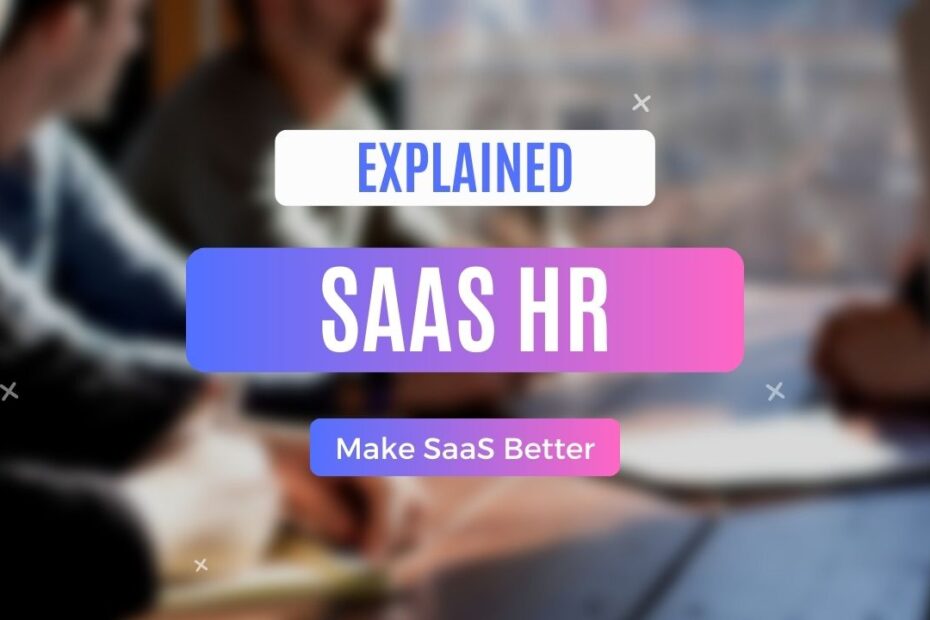Ranked at 35 out of the 800 most promising career jobs of the decade, the job of an HR has not lost the glory but is shining beyond any of the other upfront career options. While the job is highly promising leaving plenty of opportunities in every other sector, it is not any less troublesome. The challenges faced by them are as diverse as the talent they manage.
From drowning in paperwork to retaining top talent, HR professionals often find themselves juggling a multitude of tasks while striving to maintain a cohesive and motivated workforce. Amidst all this, the quest for efficiency and effectiveness has become paramount.
It is in this scenario, that the need for a SaaS HR System (Software as a Service Human Resources) becomes highly important. The platform offers a beacon of hope for HR professionals seeking to streamline operations, boost productivity, and alleviate the burdens of administrative overhead.
Interested in knowing how? Tag along with us till the end of the article to know why a SaaS HR system is most essential for your company!
What Is a SaaS HR System?
A SaaS HR system, or Software as a Service Human Resources system, is a cloud-based software solution that offers comprehensive tools for managing various HR functions. It provides functionalities such as employee data management, payroll processing, benefits administration, recruitment, performance management, and compliance tracking.
SaaS HR systems thus help to streamline HR processes, automate tasks, centralize data, and empower both HR professionals and employees with self-service capabilities, ultimately enhancing efficiency and reducing administrative burdens within organizations.
What Are the Benefits of a SaaS HR System?
1. Increases Efficiency & Productivity of HR Teams
Efficiency and productivity is increased by automating routine tasks, centralizing data, and enabling self-service functionalities. It streamlines processes such as payroll, benefits administration, and recruitment, reducing manual interventions and potential errors.
2. Centralizes Data & Enhances Data Security
A single, secure cloud-based repository is used to store all employee information and enhanced data security measures such as encryption and access controls safeguard sensitive information against unauthorized access or breaches.
3. Streamlined Recruitment, Onboarding & Performance Management
SaaS HR streamlines recruitment by automating job posting, applicant tracking and screening processes, onboarding by offering digital workflows and self-service portals, and performance management by facilitating goal-setting, feedback and evaluation tracking.
4. Improves Employee Experience
The platform enhances employee experience by offering self-service portals for tasks like updating personal information and accessing benefits. It streamlines processes, reduces paperwork, and ensures timely responses to employee queries, fostering a smoother, more efficient HR interaction and improving overall satisfaction.
5. Reduces Cost & Saves Money
The system cuts on cost and thereby saves money by eliminating the need for on-premises hardware and software infrastructure, minimizing upfront investments. With subscription-based pricing, organizations pay only for the services they use, avoiding large capital expenditures. Additionally, automation and streamlined processes reduce administrative overhead, resulting in overall cost savings.
The 3 Types of SaaS HR Systems
1. Human Resource Management System (HRMS)
HRMS is a type of SaaS HR that centralizes HR functions such as employee data management, payroll, recruitment, and performance tracking. Accessible via subscription over the internet, it offers scalability, cost-effectiveness, and automated features, streamlining HR processes, enhancing efficiency, and reducing administrative burdens for organizations of all sizes.
2. Human Capital Management (HCM)
The HCM system encompasses the strategic management of an organization’s workforce through cloud-based software solutions. It integrates HR processes such as recruitment, onboarding, training, performance management, and talent development into a unified platform.
By leveraging data analytics and automation, HCM SaaS optimizes workforce efficiency, enhances employee engagement, and drives organizational success in a cost-effective manner.
3. Human Resource Information System (HRIS)
This type of SaaS HR centralizes employee data and automates HR processes. It includes functionalities such as payroll, benefits administration, recruitment, and performance management.
HRIS streamlines HR operations, improves data accuracy, and enhances employee management efficiency. It offers scalable solutions with subscription-based pricing, reducing upfront costs and ensuring flexibility for organizations.
Key Considerations to Implement a SaaS HR System
1. Analyze Your Business Requirements & Team Needs
Analyzing business requirements and team needs is critical when implementing a SaaS HR system. It involves evaluating current HR processes, identifying pain points, and determining specific features and functionalities necessary to address them.
Understanding the unique needs of the organization and its workforce ensures that the chosen SaaS HR solution aligns with business goals, maximizes efficiency, and delivers value to both HR professionals and employees.
2. Set Your Budget
When it comes to estimating budget, it is important to determine the allocated funds for subscription fees, implementation costs, and any additional expenses such as training and customization.
Assess the financial feasibility of various SaaS HR options and choose one that aligns with your budget constraints while meeting your organization’s requirements. Setting a clear budget ensures that the implementation process remains cost-effective and within financial boundaries.
3. Ensure Scalability
Ensuring scalability is crucial when implementing a SaaS HR system to accommodate future growth and changes within an organization. Scalability allows the system to seamlessly adjust to increasing demands, such as expanding employee numbers or adding new functionalities.
With a scalable solution, organizations can avoid disruptions, maintain performance efficiency, and effectively manage evolving HR needs without requiring significant overhauls or investments in infrastructure. It ensures long-term suitability and flexibility in adapting to dynamic business environments.
4. Prioritize Training and Support
Comprehensive training ensures that HR professionals and employees understand how to effectively use the new system, maximizing its potential benefits.
Adequate support channels, such as help desks or online resources, should be established to address any questions or issues that arise during implementation and beyond.
Investing in training and support fosters user adoption, minimizes disruptions, and promotes successful integration of the SaaS HR system into the organization’s workflow.
5. Check Compliance and Security
Checking compliance and security is crucial when implementing a SaaS HR system. These systems handle sensitive employee data and must adhere to strict regulatory requirements like GDPR, HIPAA, or industry-specific standards. Ensuring compliance safeguards against legal liabilities and protects employee privacy.
Robust security measures, such as encryption, access controls, and regular audits, are essential to prevent data breaches. Selecting a SaaS HR provider with a proven track record in compliance and security reassures organizations of data integrity and risk mitigation.
Top 5 SaaS HR Solutions
1. BambooHR
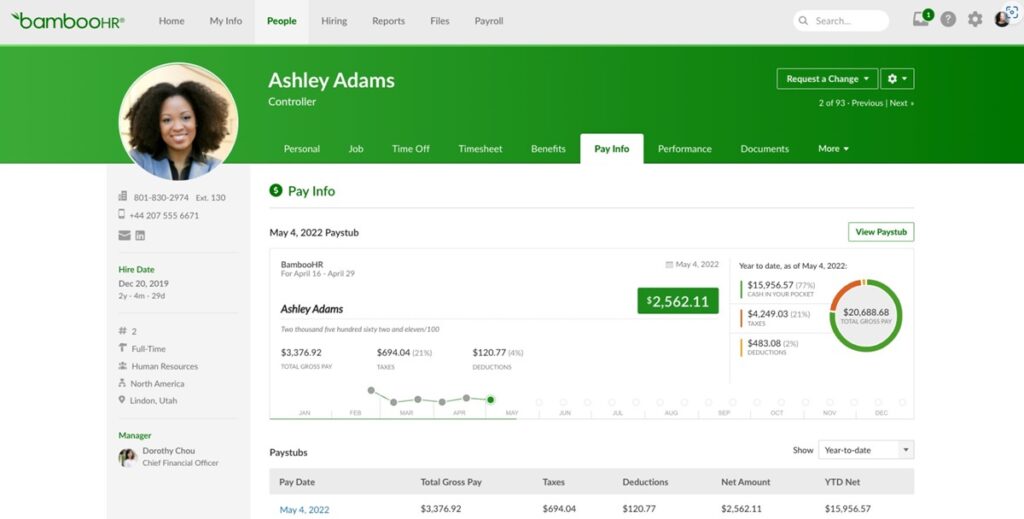
BambooHR serves as a comprehensive HR platform, consolidating employee, payroll, time, and benefit data into a single system. This integration ensures data accuracy, security, and seamless coordination, providing peace of mind for HR professionals.
It enables one to monitor work hours, handle benefits enrollment, and process payroll seamlessly, thus eliminating redundant data entry and cumbersome approval procedures.
The solution facilitates identification and recruitment of top talent. Leveraging the robust applicant tracking system and proactive onboarding tools, one can craft an engaging candidate journey and enhance the initial experiences of new hires.
Overall, it serves as a comprehensive solution for data management, offering immediate access to pre-configured reports, automated processes, and detailed analytics to support your operations and ensure continuous progress. It also provides tools to receive employee feedback so as to strengthen employee satisfaction.
2. Workday HCM
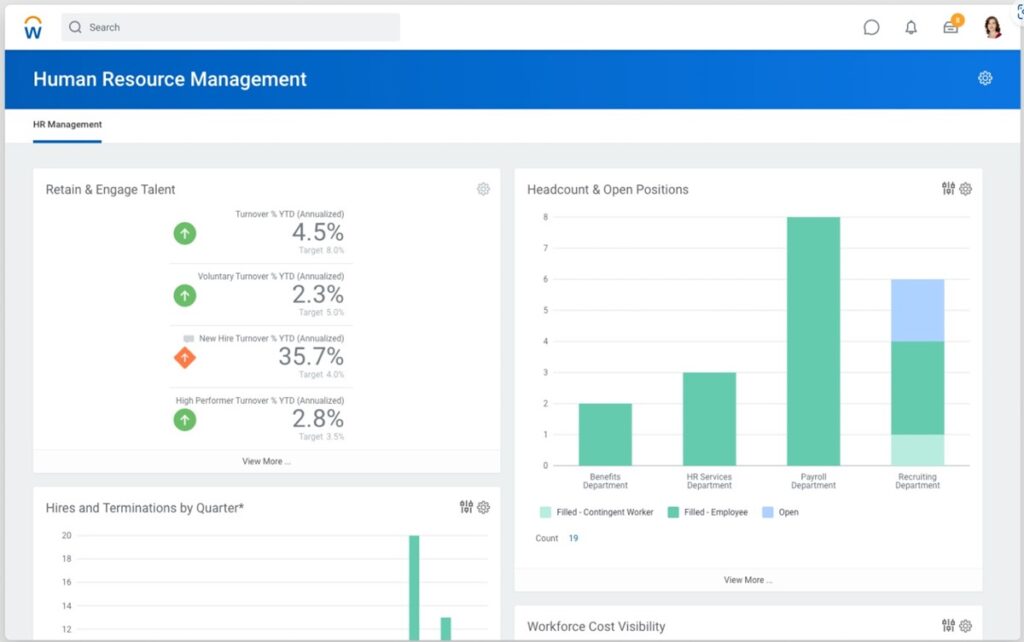
Workday HCM falls under the category of Human Capital Management SaaS HR. At the heart of Workday HCM lies the Workday Skills Cloud, which harnesses machine learning to seamlessly match talent with available opportunities. This empowers organizations of any size to enhance workforce flexibility on a large scale.
It provides smart automation throughout the entire process from attracting talent to payroll, removing manual duties and enabling your employees to maximize their productivity. The compensation and benefits tools provided enable your business to create plans tailored to accommodate various types of employees, ensuring that the workforce receives the appropriate rewards they merit.
The augmented analytics uncovers insights from extensive datasets, providing explanations for occurrences and their underlying reasons in narratives that are comprehensible to you.
As a whole, Workday HCM is versatile, adaptable, scalable, and globally applicable. It incorporates the Workday Skills Cloud, which serves as the most inclusive intelligent skills framework globally, supporting all your talent strategies driven by data.
3. Gusto

Gusto is a cloud-based SaaS HR solution that offers comprehensive payroll, benefits administration, and HR management tools designed primarily for small and medium-sized businesses (SMBs).
With its intuitive interface and user-friendly design, Gusto simplifies complex HR tasks, allowing businesses to manage employee data, process payroll, and administer benefits with ease.
One of Gusto’s key features is its automated payroll processing, which streamlines payroll calculations, tax filings, and direct deposits, reducing the time and effort required for payroll administration.
Additionally, Gusto offers a range of employee benefits options, including health insurance, retirement plans, and commuter benefits, enabling SMBs to provide competitive benefits packages to attract and retain top talent.
Gusto’s significance as a SaaS HR solution lies in its ability to empower SMBs to efficiently manage their HR operations, comply with regulatory requirements, and provide a positive employee experience, all while reducing administrative overhead and saving time and resources.
4. Deel
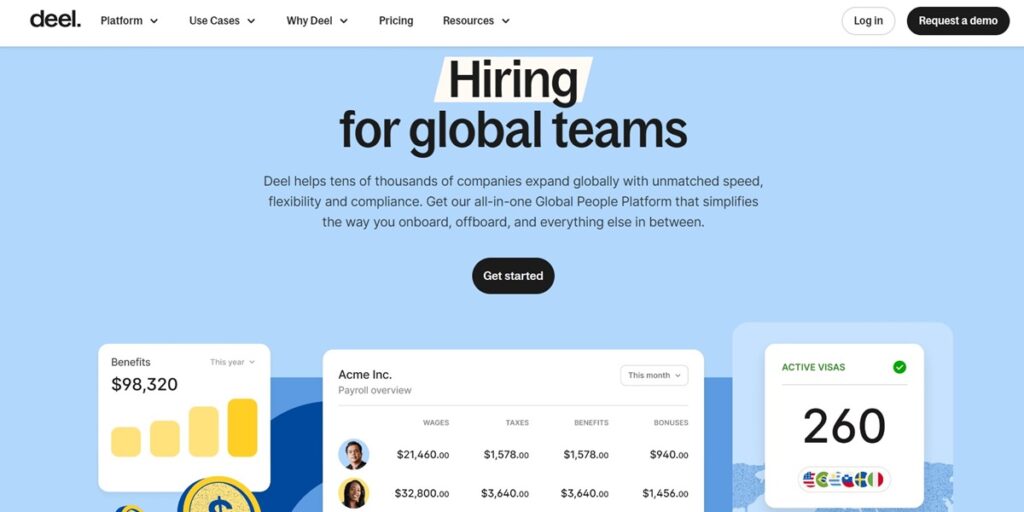
Deel is a SaaS HR solution designed to streamline and automate international hiring processes for remote teams. It offers a comprehensive suite of features, including contractor management, payroll processing, compliance tracking, and global payments.
Deel simplifies the complexities of hiring and managing remote workers across different countries by centralizing documentation, automating administrative tasks, and ensuring compliance with local labor laws and regulations.
Significantly, Deel’s platform provides transparency and efficiency throughout the hiring and onboarding process, allowing businesses to quickly and seamlessly onboard talent from anywhere in the world. Its integration with various payment methods facilitates smooth and secure transactions, enabling timely compensation for remote workers.
As a SaaS HR solution, Deel offers businesses the flexibility to scale their remote workforce efficiently while reducing administrative overhead and mitigating compliance risks. Overall, its emphasis on simplicity, compliance, and global accessibility makes it a valuable tool for businesses seeking to expand their remote teams and thrive in the digital age.
5. PeopleHR
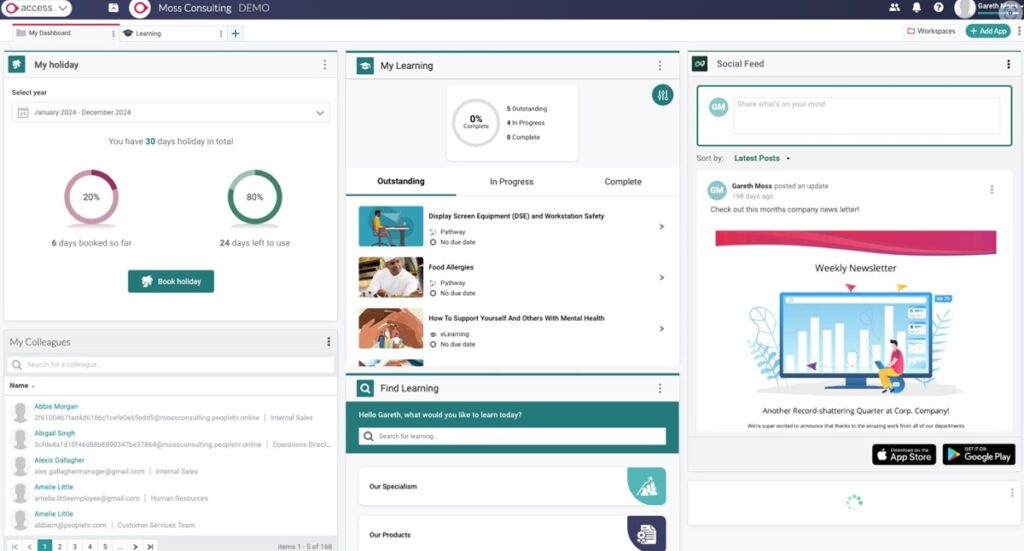
PeopleHR is a cloud-based SaaS HR solution designed to streamline human resource management processes for businesses of all sizes. It offers a comprehensive suite of features including employee data management, performance tracking, absence management, recruitment, and reporting.
PeopleHR provides a centralized platform for HR professionals to efficiently manage various HR tasks and workflows, eliminating the need for manual processes and paperwork. Significantly, PeopleHR’s user-friendly interface and customizable workflows make it accessible and adaptable to the unique needs of different organizations.
Its scalability allows businesses to grow and evolve without outgrowing their HR software. As a SaaS HR solution, PeopleHR offers several advantages, including cost-effectiveness, ease of implementation, and accessibility from anywhere with an internet connection.
Its cloud-based nature ensures data security, regular updates, and compliance with data protection regulations, enhancing overall efficiency and effectiveness in HR management.
SaaS HR: The Epilogue
SaaS HR stands upfront as one of the most efficient innovations within the realm of SaaS. Its ability to alleviate the burdens of HR departments while enhancing the recruitment and employee experience underscores its profound significance.
As all of us tend to be more engulfed within the digital world, SaaS HR is poised to play an increasingly pivotal role in shaping the future of work. With its impacts already evident in streamlining operations and fostering employee satisfaction, the possibilities for further advancements and integration are limitless.
SaaS HR not only revolutionizes HR management but also paves the way for a more agile and empowered workforce in the ever-evolving landscape of business.
😎 Also read some of our other best pieces related to SaaS –
B2B SaaS: Definition, Benefits and Top 10 Companies
18 Important Metrics SaaS Companies Should Care About
20 Best SaaS Tools for Businesses in 2024
